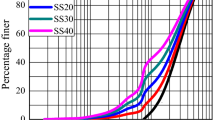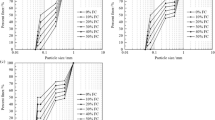Abstract
In an attempt to correlate the monotonic peak strength and the cyclic strength of sand-silt mixtures over a wide range of parameters and to clarify some of the existing confusing conclusions in the literature regarding the undrained strength response of sand-silt mixtures, a series of stress controlled cyclic and strain controlled monotonic triaxial tests was carried out on sand-silt mixture specimens of 50 mm diameter and 100 mm height with varying silt content. In these experiments, various measures of sample density was adopted through different approaches such as constant gross void ratio approach, constant relative density approach, constant sand skeleton void ratio approach, and constant interfine void ratio approach. Also the effect of relative density and confining pressure on these strengths was studied. It is observed that the limiting fines content and the relative density of a specimen play the key role in deciding the cyclic and monotonic resistance of sand-silt mixtures when studied through any approach. For any silt content with relative density more than 70%, cyclic and monotonic resistances are observed to be independent of silt content. When the undrained cyclic strengths of these specimens are plotted against their respective undrained monotonic peak strengths, it is observed that there exists a definite exponential relationship between the two with an excellent correlation coefficient. An expression is proposed in this regard to help engineers assess the cyclic strength of sand-silt mixtures from monotonic test results.























Similar content being viewed by others
Abbreviations
- B:
-
Skempton’s pore pressure parameter
- Conf Pr:
-
Confining pressure
- CSR:
-
Cyclic stress ratio
- CRR:
-
Cyclic resistance ratio
- CGVR:
-
Constant gross void ratio
- CIVR:
-
Constant interfine void ratio
- CRD:
-
Constant relative density
- CSSVR:
-
Constant sand skeleton void ratio
- D 50 :
-
Mean grain size
- e :
-
Gross void ratio
- e c :
-
Post consolidation gross void ratio
- e f :
-
Interfine void ratio
- e max :
-
Maximum gross void ratio
- e min :
-
Minimum gross void ratio
- e s :
-
Sand skeleton void ratio
- f :
-
Frequency
- FC :
-
Fines content
- G f :
-
Specific gravity of fines
- G s :
-
Specific gravity of sand
- γ d :
-
Dry density
- γ dc :
-
Post consolidation dry density
- γ w :
-
Unit weight of water
- LFC :
-
Limiting fines content
- N :
-
Cycles of loading
- ND:
-
Not determinable
- NP:
-
Nonplastic
- N L :
-
Cycles to initial liquefaction
- p′ :
-
Mean effective stress
- q :
-
Deviator stress
- RD :
-
Relative density
- RD c :
-
Post consolidation relative density
- SP:
-
Poorly graded sand
- ML:
-
Inorganic silts and very fine sands
- σ dc :
-
Deviator stress
- \( \sigma_{3c}^{\prime } \) :
-
Effective confining pressure
- S cyc :
-
Undrained cyclic strength
- S pk :
-
Undrained monotonic peak strength
- V :
-
Volume of the specimen
- V V :
-
Volume of voids
- V S :
-
Volume of soil solids
References
American Society for Tests and Materials (ASTM) Standard test method for load controlled cyclic triaxial strength of soil. ASTM D 5311-92 (Re-approved 1996), ASTM, West Conshohoken, Pa
Amini F, Qi GZ (2000) Liquefaction testing of stratified silty sands. J Geotech Geoenviron Eng ASCE 126(3):208–217
Brandon TL, Rose AT, Duncan JM (2006) Drained and undrained strength interpretation of low-plasticity silts. J Geotech Geoenv Eng ASCE 132(2):250–257
Chang NY, Yeh ST, Kaufman LP (1982) Liquefaction potential of clean and silty sands. In: Proceedings of 3rd international conference on Earthquake Microzonation, vol 2, pp 1017–1032
Chien LK, Oh YN (2002) Influence of fines content and initial shear stress on dynamic properties of hydraulic reclaimed soil. Can Geotech J 39:242–253
Dash HK (2008) Undrained cyclic and monotonic response of sand-silt mixtures. PhD thesis submitted to Indian Institute of Science, Bangalore in the Faculty of Engineering
Dash HK, Sitharam TG (2009) Undrained cyclic pore pressure response of sand-silt mixtures: effect of nonplastic fines and other parameters. J Geotech Geolog Eng 27(4): 501. doi: 10.1007/s10706-009-9252-5, http://dx.doi.org
Finn WDL, Ledbetter RH, Wu G (1994) Liquefaction in silty soils: design and analysis. Ground failures under seismic conditions, Geotechnical Special Publication, ASCE vol 44, pp 51–74
Haeri SM, Hamidi A (2005) Steady state and liquefaction characteristics of gravelly sands. J Geotech Geolog Eng 23:141–156
Hazirbaba K (2005) Pore pressure generation characteristics of sands and silty sands: a strain approach. Dissertation presented for PhD program to the faculty of Graduate School at the University of Texas at Austin
Hyodo M, Hyde AFL, Aramaki N, Nakata Y (2002) Undrained monotonic and cyclic shear behaviour of sand under low and high confining stresses. Soils Found 42(3):63–76
IS Codes (Bureau of Indian Standards)
IS: 1498–1970: “Classification and identification of soils” (1992). IS: 2720: (Part 1)–1983. “Preparation of dry soil samples.” (Part 3) Section 1: 1980. “Specific gravity-fine grained soils.” (1992), Section 2: 1980. “Specific gravity–fine, medium and coarse grained soils.”(1992). (Part 4)–1985. “Grain size analysis.” (1995). (Part 5)–1985. “Determination of liquid and plastic limit.” (1995). (Part 14)–1983. “Determination of density index (relative density) of cohesionless soils.”
Kenny TC (1977) Residual strength of mineral mixtures. In: Proceedings of the 9th international conference on soil mechanics and foundation engineering, Tokyo, vol 1, pp 155–160
Kuerbis R, Negussey D, Vaid YP (1988) Effect of gradation and fines content on the undrained response of sand. In: Proceedings on hydraulic fill structures, vol 21. Geotechnical Special Publication ASCE, pp 330–345
Lade VP, Yamamuru JA (1997) Effects of nonpalstic fines on static liquefaction of sands. Can Geotech J 34:918–928
Polito CP, Martin JR II (2001) Effects of nonplastic fines on the liquefaction resistance of sands. J Geotech Geoenv Eng ASCE 127(5):408–415
Ravishankar BV (2006) Cyclic and monotonic undrained behavior of sandy soils. PhD thesis submitted to Indian Institute of Science, Bangalore in the Faculty of Engeering
Sadek S, Saleh M (2007) The effect of carbonaceous fines on the cyclic resistance of poorly graded sands. J Geotech Geolog Eng 25:257–264
Seed HB, Tokimatsu K, Harder LF, Chung R (1985) Influence of SPT procedures in soil liquefaction resistance evaluations. J Geotech Eng ASCE 111(12):861–878
Shen CK, Vrymoed JL, Uyeno CK (1977) The effects of fines on liquefaction of sands. In: Proceedings of 9th international conference on Soil Mechanics and Foundation Engineering, Tokyo, Japan vol 2, pp 381–385
Singh S (1994) Liquefaction characteristics of silts ground failure under seismic conditions. Geotech Spl Publ ASCE 44:105–116
Sladen JA, D’Hollander RD, Krahn J (1985a) The liquefaction of sands, a collapse surface approach. Can Jeotech J 22(4):564–578
Sladen JA, D’Hollander RD, Krahn J (1985b) Back analysis of the Nerlerk berm liquefaction slides. Can Jeotech J 22:579–588
Thevanayagam S (2000) Liquefaction potential and undrained fragility of silty soils. In: Proceedings of 12th world conference on earthquake engineering, Auckland, New Zealand, p 8
Ueng TS, Sun CW, Chen CW (2004) Definition of fines and liquefaction resistance of Maoluo river soil. Soil Dyn Earthquake Eng 24:745–750
Vaid YP (1994) Liquefaction of silty soils. Ground failure under seismic conditions. Geotech Spl Publ ASCE 44: 1–16
Vaid YP, Sivathayalan S, Stedman D (1999) Influence of specimen-reconstituting method on the undrained response of sand. Geotech Test J GTJODJ 22(3):187–195
Wijewickreme D, Vaid YP (1988) Behaviour of loose sand under simultaneous increase in stress ratio and principal stress rotation. Can Geotech J 30(6):953–964
Xenaki VC, Athanasopoulos GA (2003) Liquefaction resistance of sand-silt mixtures: an experimental investigation of the effect of fines. Soil Dyn Earthquake Eng 23:183–194
Yamamuro JA, Kovert KM (2001) Monotonic and cyclic liquefaction of very loose sands with high silt content. J Geotech Geoenv Eng 127(4):314–324
Yamamuro JA, Lade PV (1997) Static liquefaction of very loose sands. Can Geotech J 34:905–917
Acknowledgments
The authors gratefully acknowledge the financial support provided by Ministry of Earth Sciences, formerly Department of Science and Technology (Seismology Division), Ministry of Science and Technology, Government of India for the work reported in this technical paper.
Author information
Authors and Affiliations
Corresponding author
Rights and permissions
About this article
Cite this article
Dash, H.K., Sitharam, T.G. Undrained Cyclic and Monotonic Strength of Sand-Silt Mixtures. Geotech Geol Eng 29, 555–570 (2011). https://doi.org/10.1007/s10706-011-9403-3
Received:
Accepted:
Published:
Issue Date:
DOI: https://doi.org/10.1007/s10706-011-9403-3




